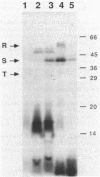Abstract
Bioluminescent bacteria require myristic acid (C14:0) to produce the myristaldehyde substrate of the light-emitting luciferase reaction. Since both endogenous and exogenous C14:0 can be used for this purpose, the metabolism of exogenous fatty acids by luminescent bacteria has been investigated. Both Vibrio harveyi and Vibrio fischeri incorporated label from [1-14C]myristic acid (C14:0) into phospholipid acyl chains as well as into CO2. In contrast, Photobacterium phosphoreum did not exhibit phospholipid acylation or beta-oxidation using exogenous fatty acids. Unlike Escherichia coli, the two Vibrio species can directly elongate fatty acids such as octanoic (C8:0), lauric (C12:0), and myristic acid, as demonstrated by radio-gas liquid chromatography. The induction of bioluminescence in late exponential growth had little effect on the ability of V. harveyi to elongate fatty acids, but it did increase the amount of C14:0 relative to C16:0 labeled from [14C]C8:0. This was not observed in a dark mutant of V. harveyi that is incapable of supplying endogenous C14:0 for luminescence. Cerulenin preferentially decreased the labeling of C16:0 and of unsaturated fatty acids from all 14C-labeled fatty acid precursors as well as from [14C]acetate, suggesting that common mechanisms may be involved in elongation of fatty acids from endogenous and exogenous sources. Fatty acylation of the luminescence-related synthetase and reductase enzymes responsible for aldehyde synthesis exhibited a chain-length preference for C14:0, which also was indicated by reverse-phase thin-layer chromatography of the acyl groups attached to these enzymes. The ability of V. harveyi to activate and elongate exogenous fatty acids may be related to an adaptive requirement to metabolize intracellular C14:0 generated by the luciferase reaction during luminescence development.
Full text
PDF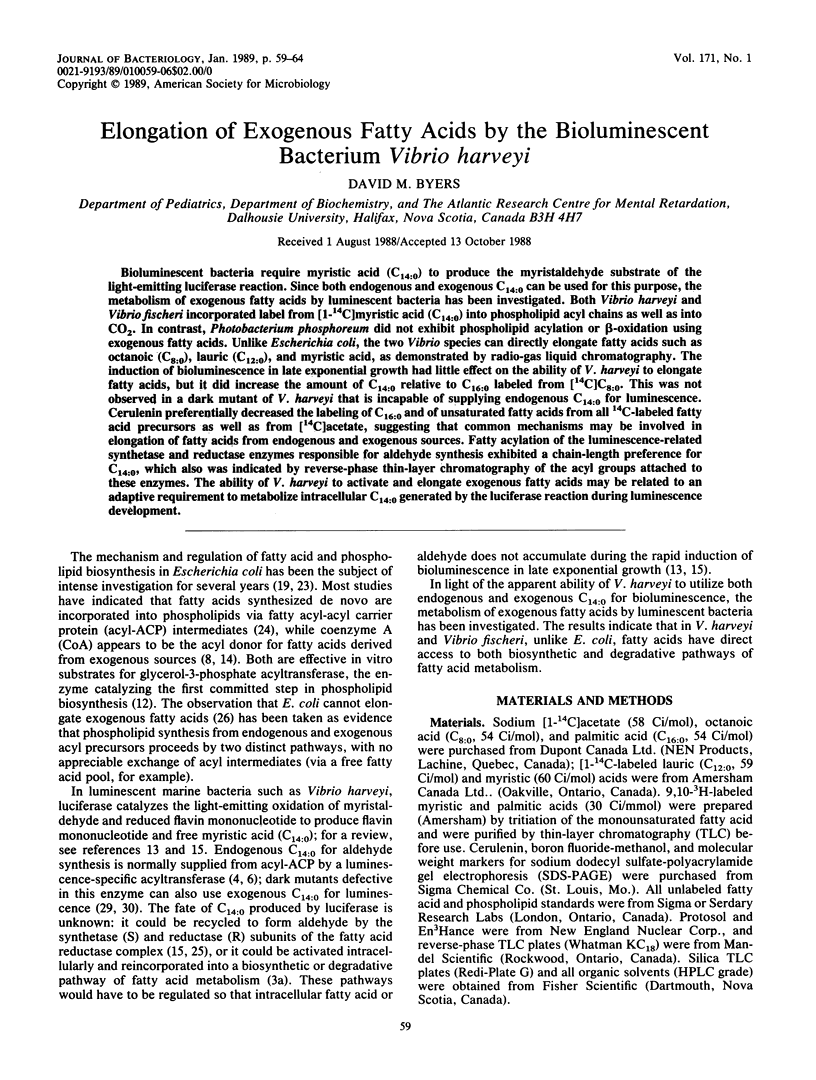
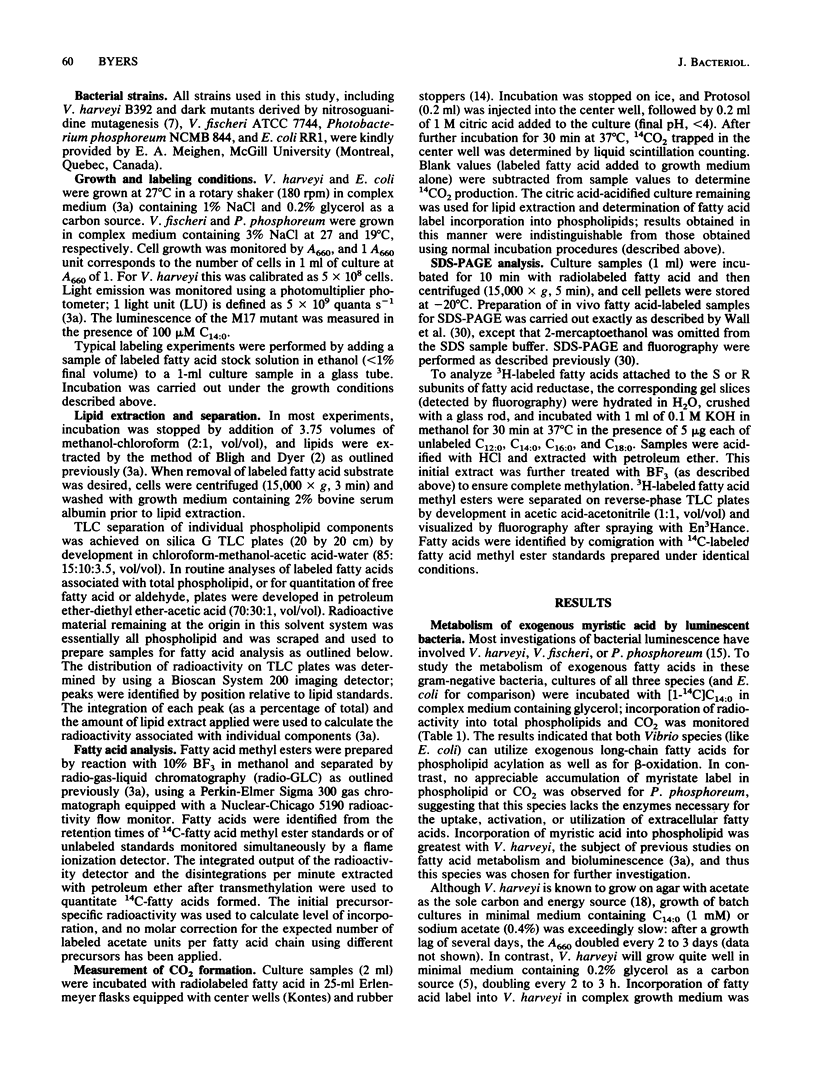
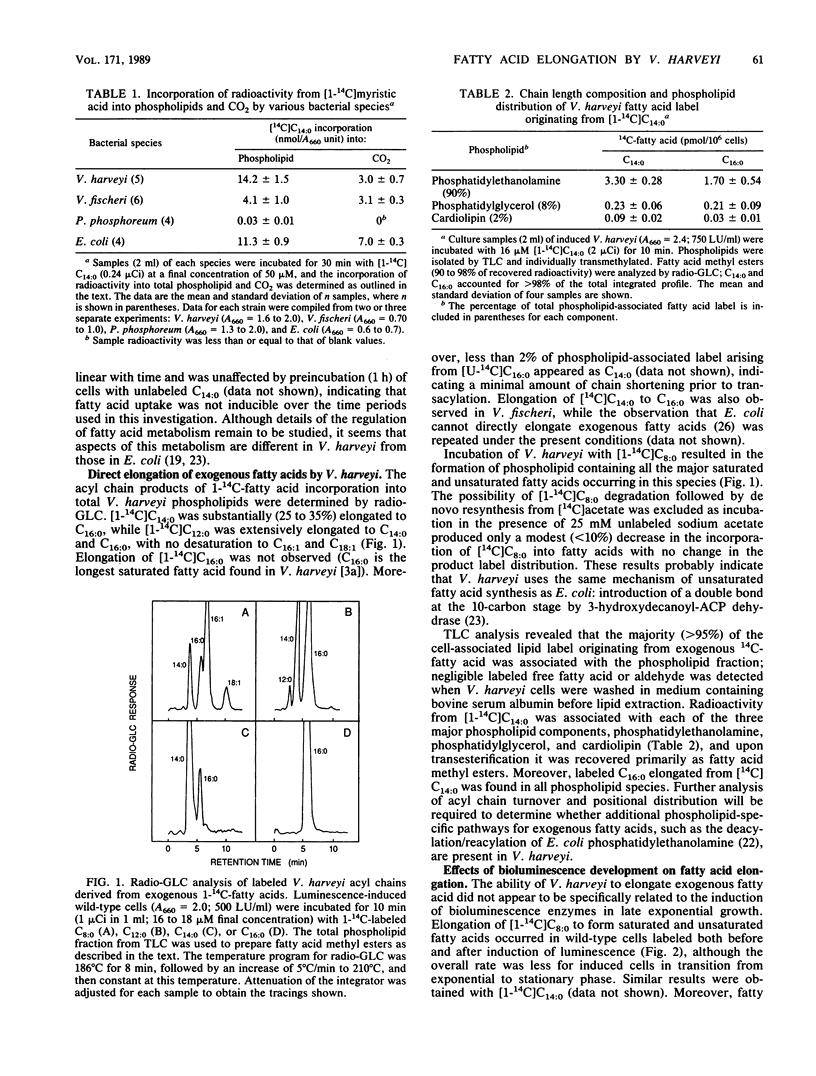
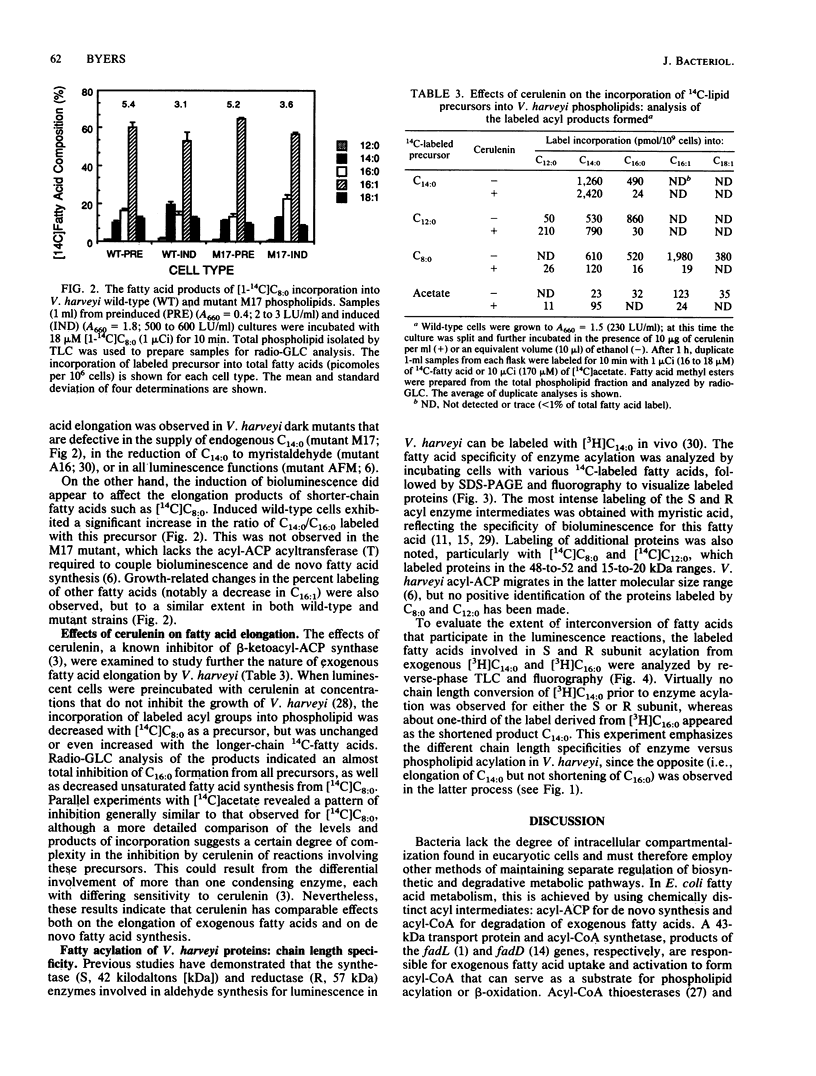
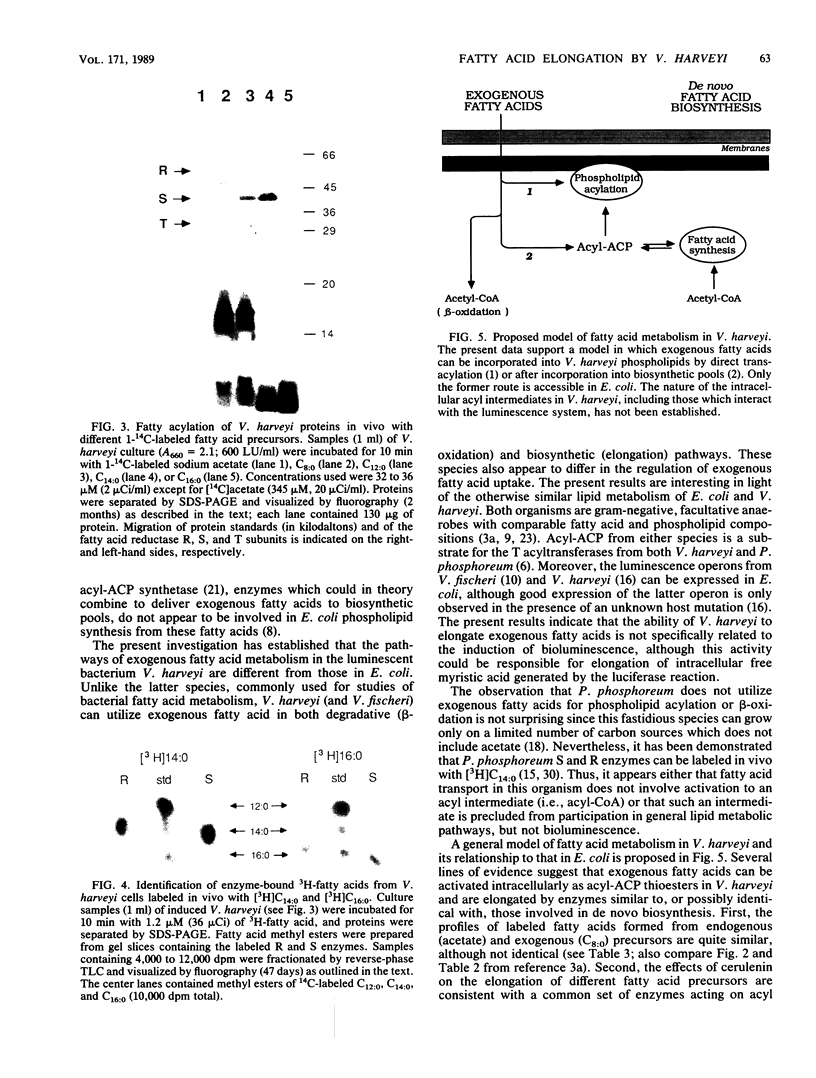
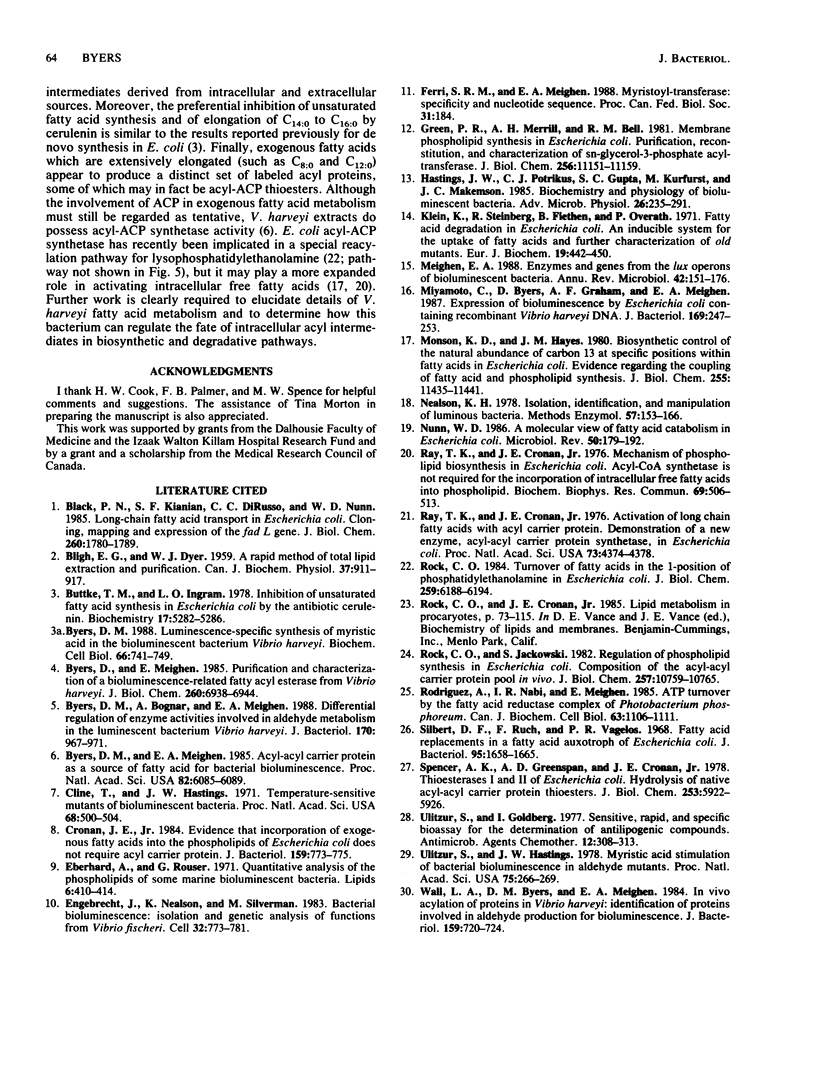
Images in this article
Selected References
These references are in PubMed. This may not be the complete list of references from this article.
- BLIGH E. G., DYER W. J. A rapid method of total lipid extraction and purification. Can J Biochem Physiol. 1959 Aug;37(8):911–917. doi: 10.1139/o59-099. [DOI] [PubMed] [Google Scholar]
- Black P. N., Kianian S. F., DiRusso C. C., Nunn W. D. Long-chain fatty acid transport in Escherichia coli. Cloning, mapping, and expression of the fadL gene. J Biol Chem. 1985 Feb 10;260(3):1780–1789. [PubMed] [Google Scholar]
- Buttke T. M., Ingram L. O. Inhibition of unsaturated fatty acid synthesis in escherichia coli by the antibiotic cerulenin. Biochemistry. 1978 Nov 28;17(24):5282–5286. doi: 10.1021/bi00617a031. [DOI] [PubMed] [Google Scholar]
- Byers D. M., Bognar A., Meighen E. A. Differential regulation of enzyme activities involved in aldehyde metabolism in the luminescent bacterium Vibrio harveyi. J Bacteriol. 1988 Feb;170(2):967–971. doi: 10.1128/jb.170.2.967-971.1988. [DOI] [PMC free article] [PubMed] [Google Scholar]
- Byers D. M., Meighen E. A. Acyl-acyl carrier protein as a source of fatty acids for bacterial bioluminescence. Proc Natl Acad Sci U S A. 1985 Sep;82(18):6085–6089. doi: 10.1073/pnas.82.18.6085. [DOI] [PMC free article] [PubMed] [Google Scholar]
- Byers D., Meighen E. Purification and characterization of a bioluminescence-related fatty acyl esterase from Vibrio harveyi. J Biol Chem. 1985 Jun 10;260(11):6938–6944. [PubMed] [Google Scholar]
- Cline T., Hastings J. W. Temperature-sensitive mutants of bioluminescent bacteria. Proc Natl Acad Sci U S A. 1971 Feb;68(2):500–504. doi: 10.1073/pnas.68.2.500. [DOI] [PMC free article] [PubMed] [Google Scholar]
- Cronan J. E., Jr Evidence that incorporation of exogenous fatty acids into the phospholipids of Escherichia coli does not require acyl carrier protein. J Bacteriol. 1984 Aug;159(2):773–775. doi: 10.1128/jb.159.2.773-775.1984. [DOI] [PMC free article] [PubMed] [Google Scholar]
- Eberhard A., Rouser G. Quantitative analysis of the phospholipids of some marine bioluminescent bacteria. Lipids. 1971 Jun;6(6):410–414. doi: 10.1007/BF02531378. [DOI] [PubMed] [Google Scholar]
- Engebrecht J., Nealson K., Silverman M. Bacterial bioluminescence: isolation and genetic analysis of functions from Vibrio fischeri. Cell. 1983 Mar;32(3):773–781. doi: 10.1016/0092-8674(83)90063-6. [DOI] [PubMed] [Google Scholar]
- Green P. R., Merrill A. H., Jr, Bell R. M. Membrane phospholipid synthesis in Escherichia coli. Purification, reconstitution, and characterization of sn-glycerol-3-phosphate acyltransferase. J Biol Chem. 1981 Nov 10;256(21):11151–11159. [PubMed] [Google Scholar]
- Hastings J. W., Potrikus C. J., Gupta S. C., Kurfürst M., Makemson J. C. Biochemistry and physiology of bioluminescent bacteria. Adv Microb Physiol. 1985;26:235–291. doi: 10.1016/s0065-2911(08)60398-7. [DOI] [PubMed] [Google Scholar]
- Klein K., Steinberg R., Fiethen B., Overath P. Fatty acid degradation in Escherichia coli. An inducible system for the uptake of fatty acids and further characterization of old mutants. Eur J Biochem. 1971 Apr;19(3):442–450. doi: 10.1111/j.1432-1033.1971.tb01334.x. [DOI] [PubMed] [Google Scholar]
- Miyamoto C., Byers D., Graham A. F., Meighen E. A. Expression of bioluminescence by Escherichia coli containing recombinant Vibrio harveyi DNA. J Bacteriol. 1987 Jan;169(1):247–253. doi: 10.1128/jb.169.1.247-253.1987. [DOI] [PMC free article] [PubMed] [Google Scholar]
- Monson K. D., Hayes J. M. Biosynthetic control of the natural abundance of carbon 13 at specific positions within fatty acids in Escherichia coli. Evidence regarding the coupling of fatty acid and phospholipid synthesis. J Biol Chem. 1980 Dec 10;255(23):11435–11441. [PubMed] [Google Scholar]
- Nunn W. D. A molecular view of fatty acid catabolism in Escherichia coli. Microbiol Rev. 1986 Jun;50(2):179–192. doi: 10.1128/mr.50.2.179-192.1986. [DOI] [PMC free article] [PubMed] [Google Scholar]
- Ray T. K., Cronan J. E., Jr Activation of long chain fatty acids with acyl carrier protein: demonstration of a new enzyme, acyl-acyl carrier protein synthetase, in Escherichia coli. Proc Natl Acad Sci U S A. 1976 Dec;73(12):4374–4378. doi: 10.1073/pnas.73.12.4374. [DOI] [PMC free article] [PubMed] [Google Scholar]
- Ray T. K., Cronan J. E. Mechanism of phospholipid biosynthesis in Escherichia coli: acyl-CoA synthetase is not required for the incorporation of intracellular free fatty acids into phospholipid. Biochem Biophys Res Commun. 1976 Mar 22;69(2):506–513. doi: 10.1016/0006-291x(76)90550-7. [DOI] [PubMed] [Google Scholar]
- Rock C. O., Jackowski S. Regulation of phospholipid synthesis in Escherichia coli. Composition of the acyl-acyl carrier protein pool in vivo. J Biol Chem. 1982 Sep 25;257(18):10759–10765. [PubMed] [Google Scholar]
- Rock C. O. Turnover of fatty acids in the 1-position of phosphatidylethanolamine in Escherichia coli. J Biol Chem. 1984 May 25;259(10):6188–6194. [PubMed] [Google Scholar]
- Silbert D. F., Ruch F., Vagelos P. R. Fatty acid replacements in a fatty acid auxotroph of Escherichia coli. J Bacteriol. 1968 May;95(5):1658–1665. doi: 10.1128/jb.95.5.1658-1665.1968. [DOI] [PMC free article] [PubMed] [Google Scholar]
- Spencer A. K., Greenspan A. D., Cronan J. E., Jr Thioesterases I and II of Escherichia coli. Hydrolysis of native acyl-acyl carrier protein thioesters. J Biol Chem. 1978 Sep 10;253(17):5922–5926. [PubMed] [Google Scholar]
- Ulitzur S., Goldberg I. Sensitive, rapid, and specific bioassay for the determination of antilipogenic compounds. Antimicrob Agents Chemother. 1977 Sep;12(3):308–313. doi: 10.1128/aac.12.3.308. [DOI] [PMC free article] [PubMed] [Google Scholar]
- Ulitzur S., Hastings J. W. Myristic acid stimulation of bacterial bioluminescence in "aldehyde" mutants. Proc Natl Acad Sci U S A. 1978 Jan;75(1):266–269. doi: 10.1073/pnas.75.1.266. [DOI] [PMC free article] [PubMed] [Google Scholar]
- Wall L. A., Byers D. M., Meighen E. A. In vivo and in vitro acylation of polypeptides in Vibrio harveyi: identification of proteins involved in aldehyde production for bioluminescence. J Bacteriol. 1984 Aug;159(2):720–724. doi: 10.1128/jb.159.2.720-724.1984. [DOI] [PMC free article] [PubMed] [Google Scholar]



